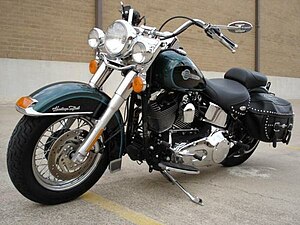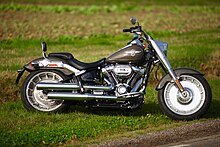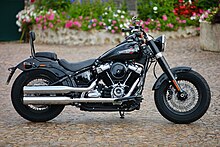Softail
This article needs additional citations for verification. (July 2009) |

The term softail refers to motorcycles and bicycles that feature a hidden rear suspension system with springs or shock absorbers to absorb bumps. Softail motorcycles give the appearance of having a hard-tail or rigid frame, normally with the shock absorbers or springs under the motorcycle and out of view.
The word "softail" is a registered trademark of Harley-Davidson motorcycles,[1] coined with the release of the FXST Softail in 1984. Since then, the word has expanded to include other motorcycles with hidden rear suspensions as well as bicycles incorporating a rear suspension.
Harley-Davidson Softail
In Harley-Davidson motorcycles, the softail frame is designed to look like the rigid frame bikes of the past, while still offering the comfort of rear suspension. The shock absorbers are positioned along the axis of the motorcycle, tucked away under the transmission on models from 1984 to 2017 and under the seat on 2018 models.




There have been many Harley-Davidson models with the Softail frame, including the Softail Standard, Custom, Springer Softail, Heritage Softail, Heritage Springer, Night Train, Deluxe, Deuce, Fat Boy, Softail Slim, the Dark Custom Cross Bones, the Dark Custom Blackline and Breakout. With the exception of the Deuce, which has a 2 inches (51 mm) backbone stretch, these motorcycles have the same engine, transmission and frame and differ mainly in the choice of fork, wheels and accessories.
Front forks
The Softail model line has included a number of choices in front fork configurations. Historically, they have also offered the Springer leading link forks that are reminiscent of the sprung front-ends that were used prior to the introduction of the Hydra-Glide in 1949. The FXST designation is used for 21" Front Wheel Bikes or when the Springer fork is used with a 21 inch wheel, while the FLST designation is used for 16" Front Wheel Bikes or when the Springer fork is used with a 16 inch wheel.
Engines
The Softail models do not have rubber-mounted engines. This led to more vibration in Evolution-engined Softails than in rubber-mounted Touring or Dyna models with Evolution engines. To compensate for this, later models used a counterbalanced version of the Twin Cam engine instead of the regular Twin Cam engine used in the Touring and Dyna models. The Twin Cam was later replaced by a variant of the Harley-Davidson Milwaukee-Eight engine for the 2018 model year. [2]
History
Bill Davis, an avid Harley rider and engineer from St. Louis, Mo. designed the softail in the mid-1970s. His first design, which he worked on in 1974 and 1975, had a cantilever swingarm pivoted at the bottom and sprung at the top with the springs and shock absorber hidden under the seat.[3] Upon working out his design, Davis built a prototype based on his 1972 Super Glide. Davis patented his design and contacted Willie G. Davidson, arranging a meeting in August 1976. Davidson was impressed, but made no commitments. Davidson replied six months later, stating that the company would not be able to use the design at the time but was still interested in it.[4]
Davis continued to develop the design, switching the pivot and the springing points around so that the springs and shock absorber were under the frame and the pivot point was at the top of the triangular swingarm. This allowed the traditional Harley-Davidson oil tank to be placed under the seat. Davis attempted to produce the new design independently as the Road Worx Sub-Shock, but the partnership he had put together for this purpose collapsed. Harley-Davidson executive Jeffrey Bleustein contacted Davis shortly afterward and began negotiations to buy Davis's design.[5] Davis sold his patents, prototype, and tooling to Harley-Davidson in January 1982.[6] After further testing and development, Davis's design was introduced in June 1983 as the 1984 Harley-Davidson FXST Softail.[4]
In April 1980, Harley-Davidson started work on its own rear suspension design that would have the look of a hard-tail motorcycle. The job was given a low priority until later in the year it was transferred to Jim Haubert Engineering, a firm that Harley-Davidson contracted yearly to custom build motorcycles and prototypes. Haubert built a prototype using his own rear suspension design that closely followed the look of the earlier Harley rigid frames. This version was completed enough for review by Harley-Davidson in January 1981.[7][better source needed]
In 2017, Harley unveiled a completely redesigned Softail frame for the 2018 model year, the first major change since the introduction of the Twin Cam engine in 2000. The 2018 Softail frame uses a differently shaped swingarm suspended by a single rear shock absorber, mounted undermeath the seat in a similar fashion to the original Haubert and Davis designs. Harley claims that the new chassis is significantly stiffer and lighter than the previous-generation Softail and Dyna platforms, the latter of which was discontinued with some of its models being carried over to the new Softail chassis.[8] The 2017 Street Bob 103 ci was dyno tested and made 65 hp (48 kW) and 88 lb⋅ft (119 N⋅m) at the rear wheel. The new 2018 Street Bob 107 ci makes 77 hp (57 kW) and 101 lb⋅ft (137 N⋅m) at the rear wheel. The 114 ci motor such as in the 2018 Heritage Classic produces 81 hp (60 kW) and 108 lb⋅ft (146 N⋅m) at the rear wheel. [9]
Customizing
The Softail is the most popular H-D model family for heavy customizing and is often used for show bikes. Many aftermarket manufacturers around the globe have specialized in Softail parts & accessories like wheels, fenders or tanks to change the look of the custom motorcycle[10]. Harley-Davidson also started an Inspiration Gallery to show their latest factory custom parts on all new models [11] - many have their origin in CVO Softails, which are handmade Limited-Editions of the regular models.
Other softails
Other motorcycles with softail rear suspension include:
- Honda VT600C, also known as the Shadow VLX
- Kawasaki Vulcan 800 and 900
- Victory Vegas
- Yamaha DragStar 400
- Yamaha DragStar 650
- Yamaha Royal Star and Royal Star Venture
- Yamaha Road Star, also known as the XV1600A or XV1700
- Yamaha V STAR 650, 950, 1100 and 1300 cc
- ZERO Engineering Type9
See also
References
- ^ "Harley-Davidson Motorcycle Softail Trademark".
- ^ https://ultimatemotorcycling.com/2017/08/22/2018-harley-davidson-softails-first-look-11-fast-facts/
- ^ Masker, Mark. "Three decades of Softail". Hot Bike. Bonnier Corporation. Retrieved 17 May 2016.
- ^ a b Field, Greg (2001). "Chapter 2: The FX and Softail Models, 1984-1999". Harley-Davidson Evolution Motorcycles. Osceola, WI USA: MBI Publishing. pp. 44–52. ISBN 0-7603-0500-5. Retrieved 2013-02-07.
- ^ Field, Greg (2002-09-01). "Father of the Softail". In Darwin Holmstrom (ed.). The Harley-Davidson Century. St. Paul, MN USA: MotorBooks International. pp. 242–243. ISBN 0-7603-1155-2. Retrieved 2012-12-26.
- ^ Field, Greg (2003). "Bill Davis and the Design of the First Softail". Harley-Davidson Softail. St. Paul, MN USA: MotorBooks International. p. 18. ISBN 0-7603-1063-7. Retrieved 2013-01-07.
Davis relented and signed the deal on January 6,1982, selling Harley the Sub Shock Wide Glide prototype, the patents for the design, all the tooling, and six complete Sub Shock frames.
- ^ Haubert, Jim (October 6, 2016), Softail Project Introduction
- ^ "2018 Harley-Davidson Softail Cruiser Lineup". Cycle World. 2017. Retrieved September 9, 2017.
- ^ Hoyer, Mark (November 28, 2017). "The 2018 Harley-Davidson Softail Street Bob". Cycle World. Retrieved December 6, 2017.
- ^ https://www.thunderbike.com/customs/softail-en/
- ^ https://www.harley-davidson.com/shop/inspiration-gallery
External links
- Cruelworld Softail at Von Dutch Kustom Cycles.

